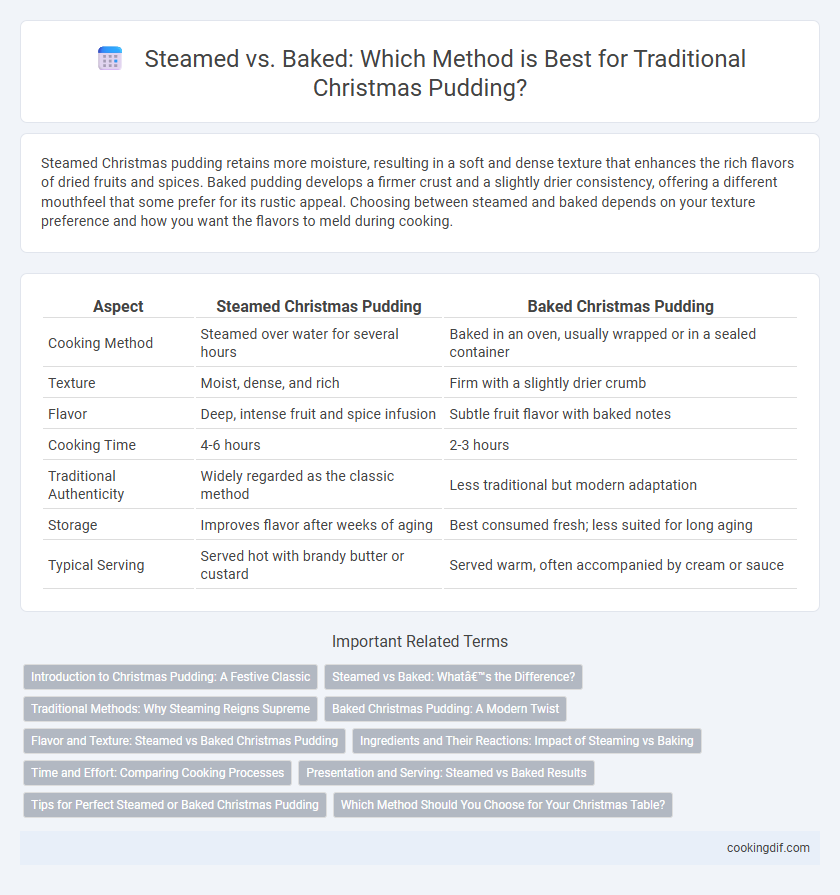Steamed Christmas pudding retains more moisture, resulting in a soft and dense texture that enhances the rich flavors of dried fruits and spices. Baked pudding develops a firmer crust and a slightly drier consistency, offering a different mouthfeel that some prefer for its rustic appeal. Choosing between steamed and baked depends on your texture preference and how you want the flavors to meld during cooking.
Table of Comparison
| Aspect | Steamed Christmas Pudding | Baked Christmas Pudding |
|---|---|---|
| Cooking Method | Steamed over water for several hours | Baked in an oven, usually wrapped or in a sealed container |
| Texture | Moist, dense, and rich | Firm with a slightly drier crumb |
| Flavor | Deep, intense fruit and spice infusion | Subtle fruit flavor with baked notes |
| Cooking Time | 4-6 hours | 2-3 hours |
| Traditional Authenticity | Widely regarded as the classic method | Less traditional but modern adaptation |
| Storage | Improves flavor after weeks of aging | Best consumed fresh; less suited for long aging |
| Typical Serving | Served hot with brandy butter or custard | Served warm, often accompanied by cream or sauce |
Introduction to Christmas Pudding: A Festive Classic
Traditional Christmas pudding, a rich and dense dessert, is typically prepared by either steaming or baking, each method impacting its texture and flavor. Steamed puddings retain moisture, resulting in a moist, tender consistency with deep, concentrated flavors from the dried fruits and spices. Baking produces a firmer, slightly drier pudding with a more caramelized crust, offering a different but equally festive taste experience.
Steamed vs Baked: What’s the Difference?
Steamed Christmas pudding retains moisture and creates a dense, rich texture by cooking it slowly over boiling water, preserving traditional flavors and ensuring even heat distribution. Baked Christmas pudding, cooked in an oven, develops a firmer crust and slightly drier texture, offering a different mouthfeel while potentially caramelizing the outer layer. The choice between steaming and baking influences moisture content, texture, and the intensity of flavors in classic holiday pudding recipes.
Traditional Methods: Why Steaming Reigns Supreme
Steaming preserves the moist texture and rich flavors essential to traditional Christmas pudding by gently cooking the dense mixture over low heat, preventing drying out. Baked puddings risk losing moisture and developing a tougher crust, which can alter the classic soft, sticky consistency. Steaming also allows gradual flavor melding of suet, dried fruits, molasses, and spices, maintaining the authentic holiday taste prized in time-honored recipes.
Baked Christmas Pudding: A Modern Twist
Baked Christmas pudding offers a modern twist on the traditional dessert by providing a firmer texture and slightly caramelized exterior that enhances flavor complexity. Unlike the classic steamed pudding, baking reduces cooking time and allows for creative variations such as incorporating nuts, dried fruits, or spices more evenly throughout. This method preserves the rich, moist characteristics of the pudding while introducing a subtle crispness that appeals to contemporary palates.
Flavor and Texture: Steamed vs Baked Christmas Pudding
Steamed Christmas pudding offers a moist, dense texture with deep, rich flavors developed through slow, gentle cooking that enhances the blend of dried fruits, spices, and suet. Baked pudding tends to have a firmer, slightly drier texture, with flavors that are more concentrated and caramelized due to the dry heat. Choosing steaming preserves moisture and softness, while baking intensifies taste but creates a less tender crumb in traditional Christmas puddings.
Ingredients and Their Reactions: Impact of Steaming vs Baking
Traditional Christmas pudding ingredients like suet, dried fruits, breadcrumbs, and spices interact differently under steaming and baking conditions. Steaming preserves moisture, allowing the suet to emulsify with the fruit juices, resulting in a dense, moist texture and intensified flavors. Baking promotes Maillard browning and caramelization, which creates a firmer crust and deeper, toasted notes but can dry out the pudding's interior.
Time and Effort: Comparing Cooking Processes
Steamed Christmas pudding typically requires longer cooking times, often ranging from 6 to 8 hours, demanding more patience but yielding a moist and rich texture. Baked Christmas pudding is generally faster, taking around 2 to 3 hours, which can be more convenient but may result in a slightly drier consistency. The steaming process involves wrapping the pudding tightly and allowing gentle heat to penetrate evenly, while baking uses dry heat that can require careful monitoring to prevent drying out.
Presentation and Serving: Steamed vs Baked Results
Steamed Christmas pudding boasts a moist, dense texture with a glossy, rich appearance that holds its shape well when sliced, making for elegant, uniform servings. Baked pudding offers a slightly drier, firmer crust with caramelized edges that enhance visual appeal and provide a contrast in texture during serving. Both methods create distinctly textured presentations, allowing for varied serving styles that highlight either the pudding's traditional moistness or its crisp, baked finish.
Tips for Perfect Steamed or Baked Christmas Pudding
Steamed Christmas pudding offers a moist and dense texture, achieved by wrapping the batter tightly and steaming for several hours to preserve its rich flavors and prevent drying out. For baked pudding, use a water bath to maintain even heat and avoid cracking, ensuring the pudding remains tender while gaining a slightly firmer crust. Always allow the pudding to mature for at least a few weeks before serving to enhance its complex spices, and reheat gently prior to serving to maintain moisture and depth of flavor.
Which Method Should You Choose for Your Christmas Table?
Steamed Christmas pudding retains moisture and produces a dense, rich texture, making it the classic choice for festive indulgence. Baked puddings, while less traditional, offer a firmer consistency and a slightly caramelized flavor from the dry heat. Choosing steamed ensures the authentic, moist depth that defines traditional Christmas pudding, while baking suits those seeking a sturdier, more textured dessert option.
Steamed vs Baked for traditional Christmas pudding Infographic

 cookingdif.com
cookingdif.com